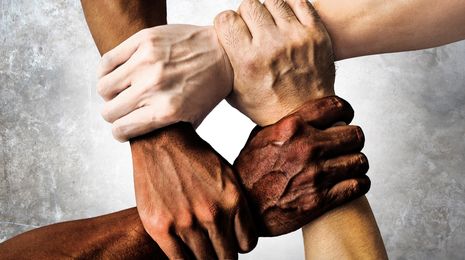The troubling return of scientific racism
Shazia Absar writes on the deep and worrying history of scientific racism, and explains why the concept of biological superiority is not as ‘lost to history’ as we like to think

Content Note: This article contains detailed discussion of racism.
In the late 1700s, the German philosopher Christoph Meiners described in his book The Outline of History of Mankind two divisions of mankind: the “beautiful white race” and the “ugly black race”. He argued that Black people were inferior, immoral and animal-like, as well as being less sensitive to pain due to having thicker nerves and lacking human emotions. He further claimed that although the skulls of black people were larger, their brains were smaller and therefore they were less intelligent than other races.
Meiners was an early practitioner of what is known as scientific racism, a pseudo-scientific belief that there is empirical evidence to support or justify racism and ideas of racial superiority and inferiority.
The ideas invoked by scientific racism are perverse and long-lasting. For example, the outdated idea that Black people experience pain differently persists in modern healthcare. Studies show that Black patients with moderate pain, as determined using pain scores, were 10% less likely to receive any pain medication compared with white patients, and those in severe pain were 20% less likely to receive opioids.
Between the 1600s and the end of World War II, scientific racism garnered support and was used to justify some of history’s greatest atrocities, such as chattel slavery and the Holocaust. However, this support dwindled due to the widespread outrage against the Nazi racial policies that led to the persecution of millions of Jews, Romanis and others deemed “sub-human” by the Nazis.
But these ideas did not disappear. Rather, they adopted a more clandestine approach, and - as Angela Saini, the author of Superior: the Return of Race Science, argues - are beginning to once again gain popularity.
“Humans had already reached the end of the evolutionary line in terms of brain power long before they left Africa for Asia and Europe”
Race science of the past was often presented in biblical language, which was deemed most appropriate at that time for such discourse. For example, in justifying slavery, people argued that God had made people unequal, making white people intelligent so they could direct the labour of others, whilst other races, specifically Black people, were given “strong backs, weak minds, and a placid disposition so that they can labour effectively”.
In contrast, the race science of today is embellished with scientific language, a language that is considered “impartial, truth-seeking and authoritative” as Saini argues. It is this change in tone that has allowed race science to resurface, but this time not as what would now be considered absurd theology with a political agenda, but as a respectable approach to justifying racism.
One of the main figures behind this resurgence of race science is Nicholas Wade, a former New York Times science correspondent. In his book A Troublesome Inheritance (which has been widely criticised and publicly denounced by more than 100 biologists and geneticists), Wade offers three arguments that are often seen as the three principles underpinning modern race science. Firstly, the concept of “race” corresponds to extensive biological differences among groups of humans; secondly, human brains have evolved differently in different races; and thirdly, these differences are supported by different racial averages in IQ tests.
At first glance, the idea of differences between the races, beyond merely physical differences such as skin colour, may not seem irrational. For example, Richard Lynn, an evolutionary scientist and self-proclaimed “scientific racist”, argue that when the white Europeans’ Cro-Magnon ancestors arrived on the continent 45,000 years ago, they faced harsher environmental conditions which led to “less intelligent individuals and tribes” dying out, leaving the “more intelligent” as survivors.
Many, however, disagree with this theory, such as the American palaeoanthropologist Ian Tattersall. He argues that humans had already reached the end of the evolutionary line in terms of brain power long before they left Africa for Asia and Europe, meaning that subsequent conditions would not have played a role in the evolution of a higher intelligence.
Furthermore, genetic studies confirm that human beings of all ethnic groups share a remarkably high proportion of their DNA (99.9%) compared with other mammals. In fact, a single subspecies of chimpanzee in central Africa has significantly more genetic variation than the entire human race, indicating there is far more to unite humans than to divide us.
“That race is human construction doesn’t mean that we don’t fall into different groups or there’s no variation”
Genetic sequencing offers further insight into the concept of “race”. Anita Foeman is the director of the DNA Discussion Project, a project which uses commercially available DNA ancestry tests to open up conversations about race and identity. Having identified as African-American her whole life, she was surprised to find that a quarter of her background was European.
Foeman is not alone as she recalls many others involved in the project who found a similar discrepancy between their perceived and actual ancestry. Therefore, although we continue to categorise most people into clear-cut “races” such as African-American, Indian or European, genetically this is often not the case. To Foeman, her work “really brought home the idea that we make race up” illustrating that “race” is a social rather than a biological construct.
Moreover, the problem with the race-IQ issue is that, whatever the scientists’ intention may be, such work can and is used to justify racist attitudes and undermine equal opportunity programmes, with the idea that we were never meant to be equal anyway, as is the view of many so-called race realists.
This is not to deny that there may be differences between population groups on the issue of IQ. However, the use of such a politically charged concept to prove an idea that has been used historically to justify many atrocities, notably chattel slavery, may have potentially disastrous consequences. As Foeman argues, “that race is human construction doesn’t mean that we don’t fall into different groups or there’s no variation, but if we made racial categories up, maybe we can make new categories that function better”.
Indeed, much needs to be done to combat the dangerous rise in race science and the profound implications it may have on modern society. After all, one thing remains clear: despite a change in tone, the race science of today is still underpinned by the same logic that allowed chattel slavery, South African apartheid and other atrocities to occur and is thus no better than the race science of the past.
If you have been affected by any of the issues raised in this article, the following information and support is available:
- Mind: A mental health charity providing free online resources.
- Samaritans: A 24-hour mental health helpline.
- The Black, African and Asian Therapy Network: A list of free services available across the UK.
- Ways To Help: A collection of resources, including petitions and bail funds, compiled by Black Lives Matter.
- Learn To Be An Active Bystander: Learn how best to challenge antisocial and discriminatory behaviour on campus.
- CamQuaranchats Podcast: The most recent episode of the CamQuaranchats podcast where students talked about their experiences of institutional racism at Cambridge.
 Comment / Plastic pubs: the problem with Cambridge alehouses 5 January 2026
Comment / Plastic pubs: the problem with Cambridge alehouses 5 January 2026 News / New movement ‘Cambridge is Chopped’ launched to fight against hate crime7 January 2026
News / New movement ‘Cambridge is Chopped’ launched to fight against hate crime7 January 2026 News / Uni-linked firms rank among Cambridgeshire’s largest7 January 2026
News / Uni-linked firms rank among Cambridgeshire’s largest7 January 2026 News / Cambridge businesses concerned infrastructure delays will hurt growth5 January 2026
News / Cambridge businesses concerned infrastructure delays will hurt growth5 January 2026 News / SU stops offering student discounts8 January 2026
News / SU stops offering student discounts8 January 2026









